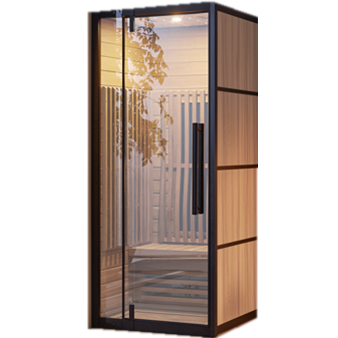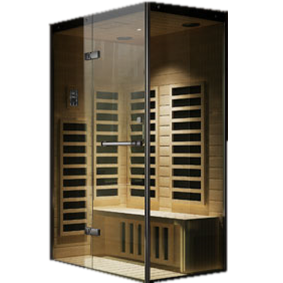Don’t miss Khruangbin, Lord Huron, and more at the Outside Festival.
Khruangbin and Lord Huron to headline 2025 Outside Festival. Steam Sauna

Be one of the first to try our new activity feed! Tap “Home” to explore.
Heading out the door? Read this article on the new Outside+ app available now on iOS devices for members! Download the app.
I got my first taste of sauna on a family vacation at the (mostly shabby) chic town of French Lick, Indiana, in the late ’80s, home to the once-glamorous West Baden Springs and the birthplace of legendary Celtics forward Larry Bird. The condo we rented for the weekend had an indoor cedar sauna, which no one in my family seemed very excited about. So I sat there alone, for a half-hour, wrapped in a towel, reading a sci-fi YA novel until the pages came unglued from the spine due to the intense dry heat.
Even to my tortured preteen soul, the sauna felt like a quiet and relaxing refuge from a stressful world. But it wasn’t until I moved to Russia in my early twenties that I really fell in love with saunas—or, as it’s called in Russian, banya (баня).
So, when my local infrared sauna studio in Boulder, Colorado, CYL (short for Change Your Life) advertised a summer special—60 days of sauna for $199—I signed up with the intention of going five times a week for the next two months.
Humans have been sweating in traditional saunas since around 2000 BC. The earliest known versions were holes dug into the ground in Northern Europe heated by hot rocks over coals. But indigenous people worldwide have used sweat lodges for health and ceremonial purposes throughout human history.
“Sauna” is a Finnish word, which is not surprising, considering that Finland is the uncontested capital of sauna culture today, boasting 3 million saunas for a country of just 5 million citizens. There’s a Finnish expression that goes “No sauna, no home.”
The Finnish sauna and Russian banya are typically communal experiences. This is a time to gather with friends, family, and neighbors while you drink beer and sweat.
To cool off, you plunge into an icy pool or lake or roll around in the snow. After a couple of rounds of this “fry and freeze” ballet, your brain is exploding with endorphins and life is good. Could this be one of the reasons Finland is consistently ranked the happiest country in the world?
In my Russia days, my girlfriends and I enjoyed a traditional Russian wood-fired banya, a Turkish steam room, a traditional Finnish cedar sauna, and multiple pools, including an icy plunge. We’d share beers or a bottle of semi-dry Soviet Champagne, apply face masks, rub ourselves with used coffee grounds to exfoliate between sessions, and share the intimate details of our lives. Saunas inspire naked truths.
There is a difference between traditional saunas (like the one I experienced in Indiana) and infrared saunas. Traditional saunas work by heating the air, which means the air temperature has to reach somewhere between 185 and 200 degrees Fahrenheit for the body to start sweating. In contrast, infrared saunas use light to heat up the body directly, requiring a much lower temperature, closer to 140 degrees Fahrenheit.
This means you can stay in an infrared sauna much longer, which allows you to reap the benefits of a sauna for a longer period of time, according to infrared proponents. Also, unlike traditional wet-dry sauna heat, infrared heat travels below the surface of the skin as far as 3 centimeters, which is why some research suggests that it can actually heal inflammation deep inside the body.
I would emerge fresh and new from my sauna sessions back in Russia, imbued with new hope and replenished resilience. The social aspect of the experience aside, after a good sweat, my mind was clear and my body was both calm and invigorated.
Researchers have labeled this state “relaxed alertness,” and it is the ideal physical state for higher-order thinking skills such as problem-solving and creativity. To quote Finland’s Nobel Prize winner in literature, F.E. Sillanpää, “The thoughts and feelings that emerge from being on the sauna bench could never appear being anywhere else in the world.”
The purported benefits of using a traditional sauna and an infrared sauna are similar, including:
While you’ve probably heard that saunas can “detox” the body, this is not necessarily true. Sweating out toxins may be a benefit of using saunas, but the research behind this is inconclusive.
CYL features eight separate rooms with futuristic, gray retractable sauna beds resting on raised platforms. Each room also features a chair, mirror, soft lighting, and a speaker piping in new-age music.
On my first visit, the front desk associate suggested that I set the customizable temperature level to 7. You can adjust the bed, lower body, and upper body to different temps (1–10) as desired.
When the associate leaves, I strip down completely, lay down on the bed covered with fluffy white towels, rest my head on the pillow, and pull the top cover up to my neck. A towel drapes down to my chest to trap in hot air. I feel like a human burrito. Or like an eccentric millionaire resting in my own personal hyperbaric oxygen chamber. Regardless, it’s quiet, cozy, and warm. I turn on a podcast and sink into the experience.
About 10 minutes in, I really start to sweat. Even my uncovered face starts pouring sweat. I place the ice-cold washcloth given to me on my forehead. In a couple more minutes, I have to remove my arms from beneath the sauna cover. When the timer finally dings, I’m relieved. My heart is beating fast and I’m soaked with sweat.
Time to towel off. I’m really missing a shower at this point, and getting my bra back on is one helluva struggle. (Recommendation: Bring a stretchy sports bra to wear post-sauna.) The studio recommends that you wait half an hour before showering so your body will continue to sweat and detox.
Afterward, my face was definitely glowing and soft. I felt at ease. Later that night, I slept like a baby.
As any good researcher will tell you, correlation does not equal causation. So, whenever trying a new wellness trend, it’s important to maintain a healthy skepticism. Here are my personal takeaways after 30 days of sweating four to six times a week.
That post-sauna glow lasts all day, but after a month, my acne is significantly better and even the texture of my middle-aged skin is smoother. The blackheads are mostly gone with only a smattering remaining on my nose. The skin on my body is also smoother and softer. I find myself caressing my arms, delighting in their softness.
However, the chronic eczema between my fingers has seen no noticeable improvement. This is disappointing.
You may have heard that saunas act almost as a “replacement” for exercise, in that they make the body sweat and lead to weight loss. While it’s true you’ll lose water weight through sweat, you’ll most likely immediately regain it once you rehydrate.
According to my FitBit, my resting heart rate is typically between 70–75 beats per minute (bpm). While in the infrared sauna, my heart rate increases to a max of 110–115 bpm, which is the equivalent of a brisk walk for me—not an intense workout.
I do think that infrared sessions would be a good option for those with injuries that limit mobility. It’s a way to get some passive cardio activity without movement. But then, it’s best to consult with a doctor before trying that out.
Instead of turning to saunas only as an exercise or a way to lose weight (which they are not), it’s more helpful to see them as a means of overall self-care.
I returned to the gym (OrangeTheory and heavy lifting) the same week I started going to the sauna, and I can definitely say that I experienced far less muscle soreness than usual. If you engage in an exercise program, you might consider adding sauna sessions to the mix.
I’ve had plantar fasciitis on my left foot on and off for more than a decade. At some points, it has seriously hindered my quality of life. I feel like the combination of going to the gym and infrared sauna has helped my pain tremendously. I only feel a little soreness in my heel first thing in the morning. After a few stretches, it’s gone.
I look forward to my sauna time as “me time.” The experience itself is meditative and relaxing, and it also gives my mind uninterrupted time to wander and explore new ideas. Much like soaking in a hot tub, problems do seem to “melt away” when laying in the sauna. I always leave feeling refreshed and inspired.
Not quite! Although the infrared sauna experience is a far cry from the communal, celebratory sauna experiences I’ve known in Finland and Russia, it has its own pleasures and health benefits.
An infrared sauna session feels more American—like an expensive, efficient, prescriptive life hack engineered to boost your mood and productivity, rather than an hours-long immersive experience shared with friends.
I’ll probably keep going after my 60 days are up, but I’ll need to schedule a trip back to Finland soon to get a taste of the real deal.
There are potential health risks associated with using saunas. If you have a health condition such as multiple sclerosis, are pregnant or trying to conceive, or if you’re sick, it’s advised that you don’t use a sauna. Those with blood pressure issues, heart conditions, skin conditions, or heat intolerance should exercise caution before using a sauna. If you’re unsure as to whether using a sauna (traditional or infrared) is right for you, be sure to consult a doctor or health care professional.

Home Sauna Price It’s essential that you hydrate before and after a sauna session so you don’t experience dehydration.